Two Unique Dives in Iceland
Recently I spent two weeks in Iceland, a country that has some interesting features such volcanoes, glaciers, icebergs, geysers and fiords. Add to this many birds including puffins, a difficult language and a friendly people. In June when I was there, although it definitely was not tropical, it was mostly sunny, and the daylight lasted nearly 24 hours.
Iceland has a population of about 320,000 compared to Tasmania's approx 500,000, and is about one and a half times the size of Tasmania, with one main road running round the coastline, the interior being mostly uninhabited and mountainous with glaciers including the largest in Europe. Most of the population live in the capital, Reykavik, which has an international airport with flights from Europe and North America. You can also get there by a ship ferry from Denmark, which I did as I was travelling with a motorcycle.
When I planned to visit Iceland, I was unaware of the diving possibilities, however a google search uncovered two unique dives, Strytan and Silfra which I made up my mind to do during the trip and are described below:
Strytan
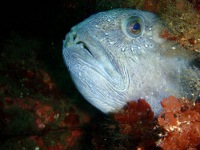 |
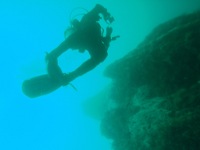 |
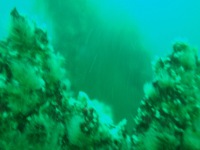 |
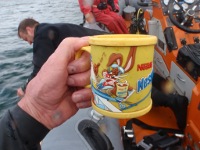 |
Strytan is the name of a thermal vent in the sea floor where hot (80 degree) fresh water is discharging into the cold (5 degree) sea in the fiord near the northern town of Akeryeri, at an estimated rate of 100 litres per second. As the hot water discharges into the cold, some of the dissolved salts precipitate as solids and over the years have formed a huge vertical chimney that rises 60 metres from the sea floor and is covered in growth and plenty of fish, including the wolffish pictured.
There are other such thermal vents in the sea, but Strytan is the only one known that is at a dive able depth, as it rises to only 20 metres from the surface, and is close to the coast. My dive was organised by Erlendur, a friendly Icelander who has been a commercial diver, lives in Akeryeri, and was involved in discovering Strytan. He runs a dive shop from an old herring factory, and takes you out on a rigid inflatable to the site and supplies all the diving equipment, as well diving with you. When diving on Strytan, you can see the hot water rising from the chimney, and you need to be careful with buoyancy due to its upward drift. You can feel the heat through your gloves if you put your hands near a vent. After the dive Erlendur made a cup of hot chocolate from the vent water that he collected, which tasted ok. Below are some of photos from the dive:
Silfra
Silfra is the name of a crack in the earth between the American and European tectonic plates upon which Iceland sits, and which are drifting apart by a few centimetres each year. This has opened up a fissure which is filled with glacial water which is very cold (2 degrees) and very clear (100 metres visibility), having been filtered for many years during its passage through the ground to the fissure that leads to a large inland lake.
Silfra is located about 75 km from Reykavik in a national park. I dived Silfra through a Reykavik dive shop named Dive Iceland, who supplied all the gear, a guide and the transport to and from the site. The dive I did finished about 9pm, but it was still broad daylight due to the midsummer sun.
The Silfra crack is about 500 metres long and varies in depth and width from a few metres to over 60 metres. It is mostly rocks but there are some areas of sand / silt and algae growth. There are a few small fish, but what makes it so remarkable is the visibility. It is so clear that you feel like you are swimming in air, and it takes a bit of getting used to. There is a small current flow along crack and the deeper water has a blue tinge to it. There are a couple of swim throughs, and some out of bounds caves that lead off to who knows where.
One thing is that you need to be fit and strong to do the walk back to the car park with all your gear at the end of the dive.
Below are some photos of the dive:
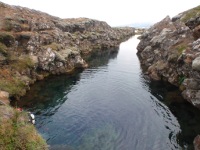 |
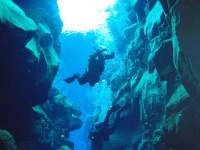 |
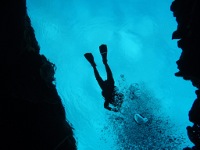 |
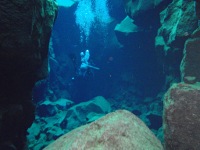 |
 South West of WA
South West of WA Iceland
Iceland